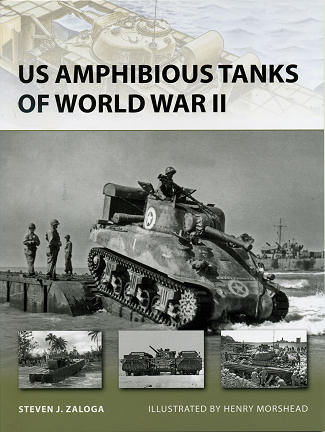 One of the
challenges of amphibious landings was how to get armor ashore. Due to their
weight, landing craft of the era could not carry them and those that could could
not get them up to the beach. This was particularly the case in the Pacific
where reefs had to be crossed.
One of the
challenges of amphibious landings was how to get armor ashore. Due to their
weight, landing craft of the era could not carry them and those that could could
not get them up to the beach. This was particularly the case in the Pacific
where reefs had to be crossed.
What was needed was something that worked. The most logical
method was to waterproof the tank and have engine intakes and exhausts that were
tall enough to allow most of the tank to be submerged and crawl along the
bottom. Of course, this took a lot of research and work as even in a piece of
armor, there were a myriad number of seams that would allow in water and you had
to have an electrical system that was even more water-proof. Water-resistant
just would not cut it.
Then there was the situation of what to do if the water was
too deep. For this latter there were several attempts made to attach pontoons of
some sort to the tank, allowing the movement of the treads or the attachment of
outboard motors to move the tank in shore. The British came up with the DD tank
that put a large, waterproof canvas screen around the tank which took care of
the displacement situation and in the rear, a pair of propellers that would get
power from the engine via a PTO to allow the tank to swim however far it had to
to get to shore. The down side of this was that the mechanism was somewhat
complex, a tear in the canvas would sink the tank and the gun could not be
operated until the tank reached shore and the screen was retracted.
As most of you know, both a 'wading' tank and the DD tank
were used in combat with the US only using DD tanks during the Normandy Landing,
the landing in Southern France and the Rhine crossing. In the Pacific, the
wading tank with the big inlet/exhaust stacks was used. At Normandy, many of the
DD tanks were released too far from shore and in water that was too rough. Many
sank, but many also made it to shore where they were put to good use.
In the Pacific, wading tanks worked fairly well as did armed
Amtracks. However, the Amtracks had the disadvantage of light armor and many
were lost in landings. A rather successful Pontoon set up was tried, but the end
of the Pacific war resulted in little use.
Steven J. Zaloga does his usual masterful job of telling the
story of the amphibious tank. From its beginnings to testing to all of its
various operational uses, it is all right here. In addition, there are the usual
large number of period photos and excellent illustrations to go along with it.
It is a great addition to the New Vanguard series and book that will be pulled
from your reference shelf time and time again.
September 2012
For more on the complete line of Osprey books,
visit www.ospreypublishing.com. In the US, it is
Osprey Direct at 44-02 23rd St, Suite 219, Long Island City, NY 11101., where you can
get a catalogue of available books.
If you would like your product reviewed fairly and quickly, please contact
me or see other details in the Note to
Contributors.
 One of the
challenges of amphibious landings was how to get armor ashore. Due to their
weight, landing craft of the era could not carry them and those that could could
not get them up to the beach. This was particularly the case in the Pacific
where reefs had to be crossed.
One of the
challenges of amphibious landings was how to get armor ashore. Due to their
weight, landing craft of the era could not carry them and those that could could
not get them up to the beach. This was particularly the case in the Pacific
where reefs had to be crossed.